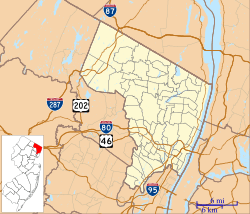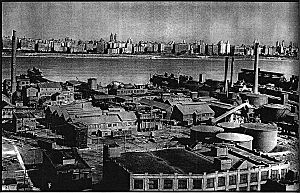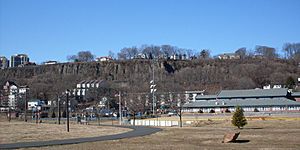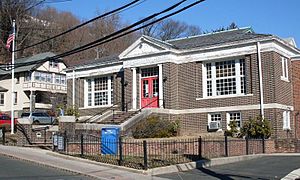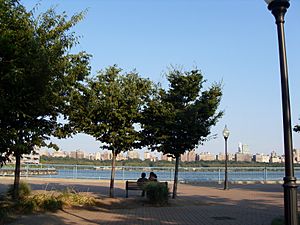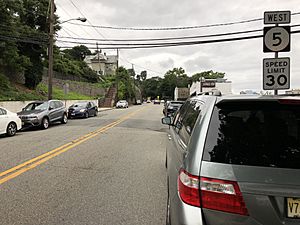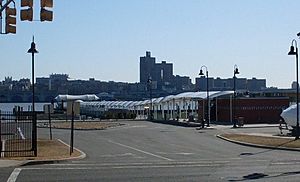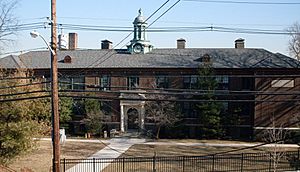Edgewater, New Jersey facts for kids
Quick facts for kids
Edgewater, New Jersey
|
||
|---|---|---|
|
Borough
|
||
| Borough of Edgewater | ||
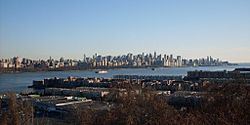
Edgewater, New Jersey in the foreground, overlooking Manhattan, New York City across the Hudson River in the background
|
||
|
||
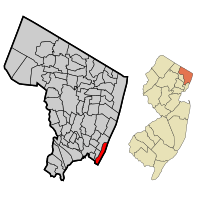
Map highlighting Edgewater's location within Bergen County. Inset: Bergen County's location within New Jersey
|
||

Census Bureau map of Edgewater, New Jersey
|
||
| Country | ||
| State | ||
| County | ||
| Incorporated | December 7, 1894 as Undercliff | |
| Renamed | November 8, 1899 as Edgewater | |
| Government | ||
| • Type | Borough | |
| • Body | Borough Council | |
| Area | ||
| • Total | 2.46 sq mi (6.36 km2) | |
| • Land | 0.97 sq mi (2.52 km2) | |
| • Water | 1.48 sq mi (3.84 km2) 60.33% | |
| Area rank | 376th of 565 in state 39th of 70 in county |
|
| Elevation | 3 ft (0.9 m) | |
| Population | ||
| • Total | 11,513 | |
| • Estimate
(2019)
|
13,364 | |
| • Rank | 212th of 566 in state 29th of 70 in county |
|
| • Density | 12,312.0/sq mi (4,753.7/km2) | |
| • Density rank | 20th of 566 in state 6th of 70 in county |
|
| Time zone | UTC−05:00 (Eastern (EST)) | |
| • Summer (DST) | UTC−04:00 (Eastern (EDT)) | |
| ZIP Code |
07020
|
|
| Area code(s) | 201 | |
| FIPS code | 3400320020 | |
| GNIS feature ID | 0885203 | |
Edgewater is a borough located along the Hudson River in Bergen County, New Jersey, United States. As of the 2010 United States Census, the borough had a population of 11,513, reflecting an increase of 3,836 (+50.0%) from the 7,677 counted in the 2000 Census, which had in turn increased by 2,676 (+53.5%) from the 5,001 counted in the 1990 Census.
The borough's history has featured the founding of the first colony in Bergen County, contribution to the Revolutionary War, a period as a "sleepy, pastoral little town" with resort hotels in the 19th century, industrialization in the early 20th century, and a transition to a rapidly growing residential community in the late 20th century.
Edgewater was incorporated as a municipality on December 7, 1894, from portions of Ridgefield Township as the Borough of Undercliff, based on the results of a referendum that passed two days earlier. The borough was formed during the "Boroughitis" phenomenon then sweeping through Bergen County, in which 26 boroughs were formed in the county in 1894 alone. The borough's name was changed to Edgewater on November 8, 1899. The borough was named for its location on the Hudson River.
Contents
History
Native American people are known to have lived in the vicinity before the arrival of colonists in the 17th century. The Lenape were a local tribe of Native Americans associated with the neighboring borough of Fort Lee. David Pietersz Devries (also transliterated as David Pietersen de Vries), the first European settler, bought 500 acres (202 ha) of land from the Tappan tribe and established the settlement of Vriessendael in what is now Edgewater. A historical plaque placed in Veteran's Field by the Bergen County Historical Society names Vriessendael as the first known colony in Bergen County with a founding date of 1640. Vriessendael was destroyed in 1643 in Kieft's War by Indians reacting to foolish actions by the Director General of the Dutch West India Company, who lived across the river in New Amsterdam, as Manhattan was then known. In pioneer days, River Road was known as the Hackensack Turnpike, and Ox [sic] Hill Road was an important route to the top of the Palisades Cliff. While Oxen Hill Road still exists as a thoroughfare, another Colonial hallmark and major local industry has only recently disappeared: shad fishing. The Undercliff section in the northern section of Edgewater was originally a colony of fishermen. In the 1980s there were still about 100 commercial fishermen in New Jersey harvesting shad from their annual spring run from the Atlantic Ocean up the Hudson River to spawn. Now there are none.
Etienne Burdett began ferry service between north Edgewater and the island of Manhattan in 1758. His gambrel-roofed house in what is now the Edgewater Colony stood until 1899. The ferry service at Burdett's Landing, which was located at the southern base of the bluff of Fort Lee, proved valuable to the American cause during the Revolutionary War. The ferry functioned as the link for supplies, information and transportation between Fort Lee on the New Jersey side of the Hudson River and Fort Washington on the New York side. In the century following the Revolutionary war, north Edgewater developed into a resort area with large hotels built in the mid- and late 19th century. It was in the 19th century that Burdett's Landing became known as "Old Stone Dock", as cobblestones quarried from the Palisades Cliffs by Russell & Read were shipped across the Hudson to fill the demand for paving Manhattan streets. Concern over the destruction caused by quarrying operations led to the formation of the Palisades Interstate Park in 1900, which was effective in preserving the cliffs. Although the first chemical plant was founded in 1843 in the south section of the borough, throughout the 19th century the town retained a bucolic character. Early in the 20th century the addition of landfill to the Hudson River changed the borough's appearance. Until that time, the Hudson River lay closer to River Road from just above Veteran's field southward to what is now the Binghamton Ferry Plaza.
The 20th century brought great change to Edgewater with industrialization, which overwhelmed the borough and filled 3 miles (4.8 km) of the shoreline with its operations. Transportation of factory goods was facilitated when the New York, Susquehanna and Western Railway cut the Edgewater Tunnel through the Palisades in 1894 to connect the borough to its main line. Edgewater was also well situated for shipping, with deep water piers on the Hudson River and access to abundant labor from Manhattan. Generally, industrial development occurred in the southern end of the borough, while the northern end remained residential. As industrialization increased in the borough, picnic grounds lost their appeal and resort hotels faded. By 1918, there were 8,044 workers employed by Edgewater's manufacturing facilities, producing primarily chemicals, dyes, and confectionery products such as oils and sugars. Prominent industries of Edgewater included a Ford assembly plant, Alcoa, Valvoline, and the American Can Company. Railroad trains served various factories, traversing tracks laid in River Road. During the first 30 years of the century, Edgewater's population quadrupled, and the transient workforce increased tenfold. Eventually the factories closed. The reasons were varied, but they included the globalization of industry, obsolete facilities and the replacement of railroad shipping by trucking, which could not run its large tractor trailer trucks on Edgewater's narrow streets.
Joseph Mitchell's essay The Rivermen, which was published in The New Yorker and is included in his book The Bottom of the Harbor, provides an evocative portrait of life in Edgewater in the early 20th century.
The late 20th century history of Edgewater was one of change from an industrialized town to a residential one. With the closing of the factories, development initially came to Edgewater in the 1960s and grew exponentially in the early 1980s, as developers began projects to convert the industrial sites that had historically led to Edgewater not being considered as an option for development. As condominiums were built along the Hudson where industry had formerly operated, the population of Edgewater grew rapidly. The population had been mostly in the 4,000 to 5,000 range from 1930 to 1990, then increased by 50% to 7,677 in 2000 and again by 50% to 11,513 in the 2010 Census. Borough council members and residents acknowledge that population growth has exacerbated the problem of increased traffic. With the transition from industrial to residential, crime statistics were down, with the police chief describing how bar fights between factory workers were commonplace in the early 1970s, while real estate values are up. Because of the expense of buying property, some currently refer to Edgewater as part of the Gold Coast. A photographic history of Edgewater describes the population and demographics change and its possible consequence this way:
Now a good number of residents live on the river in condominiums and rental apartments and town houses on land that was once the province of heavy industry. Some see this as the creation of a town divided, with the newcomers living on the east side of River Road by the Hudson River and the old-timers living on the west side of River Road.
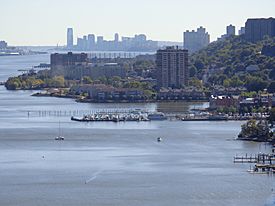
Although the borough is unrecognizable as the industrial town it once was, growing pains have left marks. When the old Alcoa plant site from 1916 began to be converted to condominiums, construction was forced to halt for cleanup of industrial contaminants, including excessively high concentrations of PCBs. In another case, construction of a condominium/shopping center in south Edgewater was interrupted for six months by safety measures to protect workers from chemical exposure in the lead- and arsenic-riddled soil. Next to this structure, behind a chain link fence lies a Superfund site. Operational Hess Oil tanks, beside the derelict Alcoa rolling mill, once the second-largest in the world, are a reminder of the borough's industrial phase. The building, occupying 1,100,000 square feet (100,000 m2) of space, was designed in 1914 and was used to roll ingots of aluminum into sheets that were used to create everything from toothpaste tubes to aircraft frames, before the facility was abandoned in 1967 due to lack of space needed to expand the facility.
Geography
According to the United States Census Bureau, the borough had a total area of 2.421 square miles (6.272 km2), including 0.935 square miles (2.422 km2) of land and 1.486 square miles (3.850 km2) of water (61.38%).
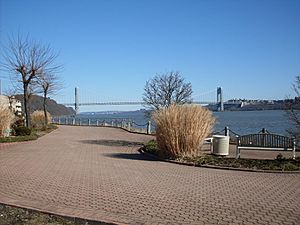
The borough is a narrow strip of land along the Hudson River, with 3.5 miles (5.6 km) of waterfront. The Palisades Cliff rises dramatically and forms a natural border on its western side, running roughly parallel to the Hudson. The towns atop the cliff are Fort Lee and Cliffside Park, north and south, respectively. Edgewater abuts Fort Lee Historic Park in the borough of Fort Lee on the north. On the south it shares a border with the township of North Bergen, which lies in Hudson County.
River Road, which overlooks the Hudson River and the Manhattan skyline, runs into and out of the town from the north and south, lying just above the level of the Hudson. Three roads lead up the Palisades Cliff: Route 5, with one switchback, ascends to Palisades Avenue, which leads north into Fort Lee and south into Cliffside Park. Gorge Road and Edgewater Road, the latter still referred to by many local residents by its Colonial-era name as Oxen Hill Road, lead up the Palisades to Cliffside Park.
The borough borders Cliffside Park and Fort Lee in Bergen County; North Bergen in Hudson County; and the New York City borough of Manhattan across the Hudson River.
Demographics
| Historical population | |||
|---|---|---|---|
| Census | Pop. | %± | |
| 1900 | 1,006 | — | |
| 1910 | 2,655 | 163.9% | |
| 1920 | 3,530 | 33.0% | |
| 1930 | 4,089 | 15.8% | |
| 1940 | 4,028 | −1.5% | |
| 1950 | 3,952 | −1.9% | |
| 1960 | 4,113 | 4.1% | |
| 1970 | 4,987 | 21.2% | |
| 1980 | 4,628 | −7.2% | |
| 1990 | 5,001 | 8.1% | |
| 2000 | 7,677 | 53.5% | |
| 2010 | 11,513 | 50.0% | |
| 2019 (est.) | 13,364 | 16.1% | |
| Population sources: 1900-1920 1900-1910 1910-1930 1900-2010 2000 2010 |
|||
As of March 2011[update] about 2,500 Japanese-Americans lived in Edgewater and Fort Lee; this is the largest concentration of Japanese-Americans in New Jersey. In the 2013-2017 American Community Survey, 35.7% of residents were identified as Asian, including 2,205 (18.1%) who were Korean, 630 (5.2%) were Asian Indian and 574 (4.7%) were Japanese.
Census 2010
As of the census of 2010, there were 11,513 people, 5,637 households, and 3,021 families residing in the borough. The population density was 12,312.0 per square mile (4,753.7/km2). There were 6,282 housing units at an average density of 6,718.0 per square mile (2,593.8/km2)*. The racial makeup of the borough was 53.29% (6,135) White, 4.95% (570) Black or African American, 0.14% (16) Native American, 35.47% (4,084) Asian, 0.06% (7) Pacific Islander, 3.35% (386) from other races, and 2.74% (315) from two or more races. [[Hispanic (U.S. Census)|Hispanic or Latino of any race were 11.10% (1,278) of the population. Korean Americans accounted for 19.6% of the population.
There were 5,637 households out of which 23.6% had children under the age of 18 living with them, 43.2% were married couples living together, 7.8% had a female householder with no husband present, and 46.4% were non-families. 39.3% of all households were made up of individuals, and 10.1% had someone living alone who was 65 years of age or older. The average household size was 2.04 and the average family size was 2.76. Same-sex couples headed 38 households in 2010, an increase from the 32 counted in 2000.
In the borough, the population was spread out with 17.7% under the age of 18, 4.1% from 18 to 24, 43.6% from 25 to 44, 23.0% from 45 to 64, and 11.6% who were 65 years of age or older. The median age was 37.2 years. For every 100 females there were 90.2 males. For every 100 females ages 18 and old there were 87.0 males.
The Census Bureau's 2006–2010 American Community Survey showed that (in 2010 inflation-adjusted dollars) median household income was $83,602 (with a margin of error of +/- $8,791) and the median family income was $114,375 (+/- $19,887). Males had a median income of $82,248 (+/- $13,946) versus $57,971 (+/- $9,987) for females. The per capita income for the borough was $58,220 (+/- $5,463). About 7.7% of families and 8.5% of the population were below the poverty line, including 15.0% of those under age 18 and 7.8% of those age 65 or over.
Census 2000
As of the 2000 United States Census, there were 7,677 people, 3,836 households, and 1,971 families residing in the borough. The population density was 9,060.6 people per square mile (3,487.2/km2). There were 4,277 housing units at an average density of 5,047.8 per square mile (1,942.8/km2). As of the 2000 census, the racial makeup of the borough was 67.12% White, 10.45% Hispanic or Latino of any race, 3.52% African American, 0.21% Native American, 23.12% Asian, 0.04% Pacific Islander, 2.94% from other races, and 3.05% from two or more races.
There were 3,836 households, out of which 20.0% had children under the age of 18 living with them, 40.0% were married couples living together, 8.4% had a female householder with no husband present, and 48.6% were non-families. 39.1% of all households were made up of individuals, and 6.3% had someone living alone who was 65 years of age or older. The average household size was 2.00 and the average family size was 2.70.
In the borough the age distribution of the population shows 15.4% under the age of 18, 5.3% from 18 to 24, 46.7% from 25 to 44, 23.6% from 45 to 64, and 8.9% who were 65 years of age or older. The median age was 36 years. For every 100 females, there were 94.9 males. For every 100 females age 18 and over, there were 92.9 males.
The median income for a household in the borough was $63,455, and the median income for a family was $72,692. Males had a median income of $50,795 versus $49,238 for females. The per capita income for the borough was $42,650. About 6.2% of families and 8.6% of the population were below the poverty line, including 16.5% of those under age 18 and 13.6% of those age 65 or over.
In the 2000 Census, 11.83% of Edgewater's residents identified themselves as being of Korean ancestry, which was the ninth highest in the United States and seventh highest of any municipality in New Jersey, for all places with 1,000 or more residents identifying their ancestry. 3.22% of residents identified themselves as being of Japanese ancestry, which was the third highest of any municipality in New Jersey, behind Fort Lee (6.09%) and Demarest (3.72%). In the 2010 Census, those reporting Korean ancestry had increased to 19.6% of the population (2,258 residents), while the percentage of Japanese residents had risen to 4.9% (560 residents).
Parks and recreation
22-acre (89,000 m2) Veterans' Field offers residents recreational opportunities and provides space for a Community Center and American Legion Post 116. Veterans' Field is located on River Road (County Route 505) in the north section of Edgewater, lying along the Hudson River. It has indoor and outdoor basketball courts, three softball fields, a 1/3 mile-long track which accommodates runners, walkers and skaters; tennis courts, a Little League field and a playground. It is also the site of a large American flag which can easily be seen from across the river in Manhattan. A plaque commemorating the New Netherland plantation of David Pietersen de Vries, Vriessendael, is located at the entrance to the field on the west. Although the field extends well to the east, it did not exist in de Vries's day. In 1922, landfill was dumped into the Hudson River from the construction site of Yankee Stadium in the Bronx, which gives Veteran's Field its current dimensions. As of September 16, 2011, Veteran's Field was closed due to soil contamination in the fill brought to the site.
Arts and culture
Borough Hall, the Binghamton Ferry and the Edgewater Public Library are listed on both the National Register of Historic Places and the New Jersey Register of Historic Places. Constructed in 1904, Borough Hall was granted $406,000 by Senate and General Assembly of New Jersey in August 2009 for restoration of the building. Among other renovations, the missing gargoyles were returned to the 1902 edifice.
The Binghamton Ferry, permanently anchored at the Binghamton Shopping Plaza, was built in 1904–1905 by Newport News Shipbuilding and Dry dock Company, Newport News, Virginia The only double-ended Steam powered ferry boat still on the Hudson River, the Binghamton ferried passengers from New Jersey to Barclay Street in Manhattan for many years and was retired in 1967.
The last remaining of 15 Carnegie libraries in New Jersey built with $15,000 in funds from the Carnegie Foundation, the Edgewater Free Library was dedicated on February 8, 1916. Edgewater opened its library in 1910, prior to the donation from the Carnegie Foundation, with 817 books on its shelves.
In addition to these sites, the Eleanor Van Gelder School is listed on the New Jersey Register of Historic Places.
The River Walk
The promenade along the Hudson is part of the Hudson River Waterfront Walkway. In 1988, construction of a waterfront walkway was mandated by state law that would allow walkers a path along the Hudson River from Bayonne up to the George Washington Bridge. Although property owners were required to build and maintain it, many gaps remain. Of the 18.5 miles (29.8 km) called for, only 11 miles (18 km) are complete, and many of the gaps occur in Edgewater. The completed stretches offer paths for walking along the Hudson River with views of Manhattan.
Edgewater parrots
Edgewater is the home of a free-flying colony of monk parakeets, also known as Quaker parrots, which are native to South America. These small, green parrots have lived in Edgewater since at least 1980 and were numbered at 200 to 230 in a 2008 article in The New York Times. They are easily seen in Memorial Park and its vicinity at River Road and Route 5. The parrots build large nests of twigs and down which become permanent residences. Nests four-feet long can be seen near the intersection. How the birds came to Edgewater is unknown, though a widely accepted story traces their origin to an escape from a damaged crate at John F. Kennedy Airport in the 1960s.
The birds have built nests against transformers on utility poles. Citing the risk of fire, the utility PSE&G has destroyed such nests. This has brought the utility into conflict with parrot advocates. As of 2008, PSE&G has agreed not to take down nests during breeding season.
In popular culture
Edgewater was used as a filming location for the 1997 feature film, Cop Land, starring Sylvester Stallone, Robert De Niro, Harvey Keitel and Ray Liotta.
Transportation
Roads and highways
As of May 2010[update], the borough had a total of 11.19 miles (18.01 km) of roadways, of which 6.38 miles (10.27 km) were maintained by the municipality, 4.03 miles (6.49 km) by Bergen County and 0.78 miles (1.26 km) by the New Jersey Department of Transportation.
County Route 505 is the main north–south road in the borough. Route 5 also passes through and ends at CR 505.
Interstate 95 (both the New Jersey Turnpike and George Washington Bridge), U.S. Routes 1/9, U.S. Route 46 and the Palisades Interstate Parkway are all nearby and accessible via CR 505 in Fort Lee.
Public transportation
New Jersey Transit buses include the 156, 158 and 159 routes serving the Port Authority Bus Terminal in Midtown Manhattan; the 188 to the George Washington Bridge Bus Terminal; and local service on the 751 and 755 routes.
Ferry service to West Midtown Ferry Terminal in Manhattan is offered by NY Waterway at Edgewater Landing, located where Route 5 comes into River Road. Parking at the terminal is not available; however a shuttle bus operated by the borough is available to transport passengers to the landing. In Manhattan there is free transfer to a network of buses operated by NY Waterways.
Several ferries operated in Edgewater in the past, with the old Edgewater Ferry Terminal historically located about 100 yards from the current ferry terminal. The last ferry in the 20th century crossed the river in 1950. The borough was also the site of the trolley terminal for numerous electric lines in New Jersey. Situated across River Road from the old Ferry Terminal, it met passengers arriving from Manhattan. Its service included transportation to the top of Palisades Cliff. The trolley stopped running in 1938.
Bike lanes on River Road were completed in July 2012, in connection with a road re-paving project.
Economy
Edgewater was the location of the Lever Brothers research center where chemist Vincent Lamberti, a holder of over 118 patents, spent most of his 40 years for the company, and where he invented Dove soap, the first soap not made with animal fat.
Edgewater has five main shopping areas. From north to south they are Town Centre, the Binghamton Shopping Plaza, Mitsuwa Marketplace, Edgewater Commons and City Place. All are located on the river side of River Road and bordered by the River Walk. As recently as 1984 the town had no supermarket. Now groceries may be purchased at Whole Foods Market in Town Centre, Trader Joe's at the Binghamton Plaza, Japanese-labeled groceries at Mitsuwa Marketplace and at Acme Markets in Edgewater Commons. Company-operated shuttle buses that ran on Wednesdays and Thursdays, bringing shoppers to Mitsuwa from Manhattan, were terminated as of 31 December 2014[update].
Education
The Edgewater Public Schools serves public school students in pre-kindergarten through sixth grade. As of the 2018–19 school year, the district, comprised of two schools, had an enrollment of 1,022 students and 70.3 classroom teachers (on an FTE basis), for a student–teacher ratio of 14.5:1. With district enrollment increasing rapidly, George Washington School opened in September 2012, having been constructed with a third floor to accommodate enrollment growth in the district that was anticipated to rise from 628 in 2011 to as much as 925 in 2015. Schools in the district (with 2018–19 enrollment data from the National Center for Education Statistics) are George Washington School with 554 students in grades PreK-2 and Eleanor Van Gelder School with 447 students in grades 3-6.
For seventh through twelfth grades, public school students from the borough are sent to the Leonia Public Schools as part of a sending/receiving relationship. Schools in the district attended by Edgewater students (with 2018–19 enrollment data from the National Center for Education Statistics) are Leonia Middle School with 533 students in grades 6 - 8 (Edgewater students attend for grades 7&8) and Leonia High School with 740 students in grades 9 - 12.
Public school students from the borough, and all of Bergen County, are eligible to attend the secondary education programs offered by the Bergen County Technical Schools, which include the Bergen County Academies in Hackensack, and the Bergen Tech campus in Teterboro or Paramus. The district offers programs on a shared-time or full-time basis, with admission based on a selective application process and tuition covered by the student's home school district.
Holy Rosary Church in Edgewater is one of the sponsors of the Christ the Teacher School, an interparochial Catholic K-8 school of the Roman Catholic Archdiocese of Newark, in Fort Lee.
Notable people
People who were born in, residents of, or otherwise closely associated with Edgewater include:
- Ryan Allen, opera singer
- Amerie (born 1978), R&B singer
- Greg Amsinger (born 1979), sportscaster for MLB Network
- Nadiya Anderson (born 1986), television personality known for appearing with her twin sister, Natalie on The Amazing Race and Survivor: San Juan del Sur.
- Natalie Anderson (born 1986), television personality who appeared on The Amazing Race with her identical twin sister Nadiya; both later appeared on Survivor: San Juan del Sur, where Natalie was crowned Sole Survivor, winning the show's $1 million prize
- Coco Austin (born 1979), model
- Tyson Beckford (born 1970), model
- Miri Ben-Ari (born 1978), Israeli-American violinist
- Cardi B (born 1992), rapper
- Maksim Chmerkovskiy (born 1980), professional dancer on the TV show Dancing with the Stars
- Liz Claman (born 1963), Fox Business Network anchor
- Paige Conners (born 2000), Israeli-American pairs figure skater who competed at the 2018 Winter Olympics with her skating partner, Evgeni Krasnopolski, representing Israel
- Barbara Corcoran (born 1949), real estate agent and investor
- Harris Faulkner (born 1965), newscaster and television host for Fox News Channel
- Luke Higgins (1921–1991), football player
- Ice-T (born 1958), rapper and actor
- JoJo (born 1990), singer
- Peter Moraites (1922–2014), Speaker of the New Jersey General Assembly;
- Rachel Noerdlinger (born 1970), publicist, former chief of staff to Chirlane McCray, the wife of Mayor of New York City Bill de Blasio
- Nick Prisco (1909–1981), football tailback, played one season in the NFL with the Philadelphia Eagles
- Q-Tip (born 1970), rapper
- Geraldo Rivera (born 1943), newsman
- John Sterling (born 1948), radio broadcaster for the New York Yankees
- Francis R. Tillou (c. 1795–1865), lawyer and politician; operated a ferry between Edgewater and New York City; lived on an estate he called "Tillietudlem", located on the present site of the Edgewater Public Library
- Osi Umenyiora (born 1981), defensive end for the New York Giants
- Chien-Ming Wang (born 1980), pitcher, played for the New York Yankees
- Jim White (1920–1987), NFL tackle, played for the New York Giants
- Norman Joseph Woodland (1921–2012), inventor of the barcode
See also
 In Spanish: Edgewater (Nueva Jersey) para niños
In Spanish: Edgewater (Nueva Jersey) para niños



